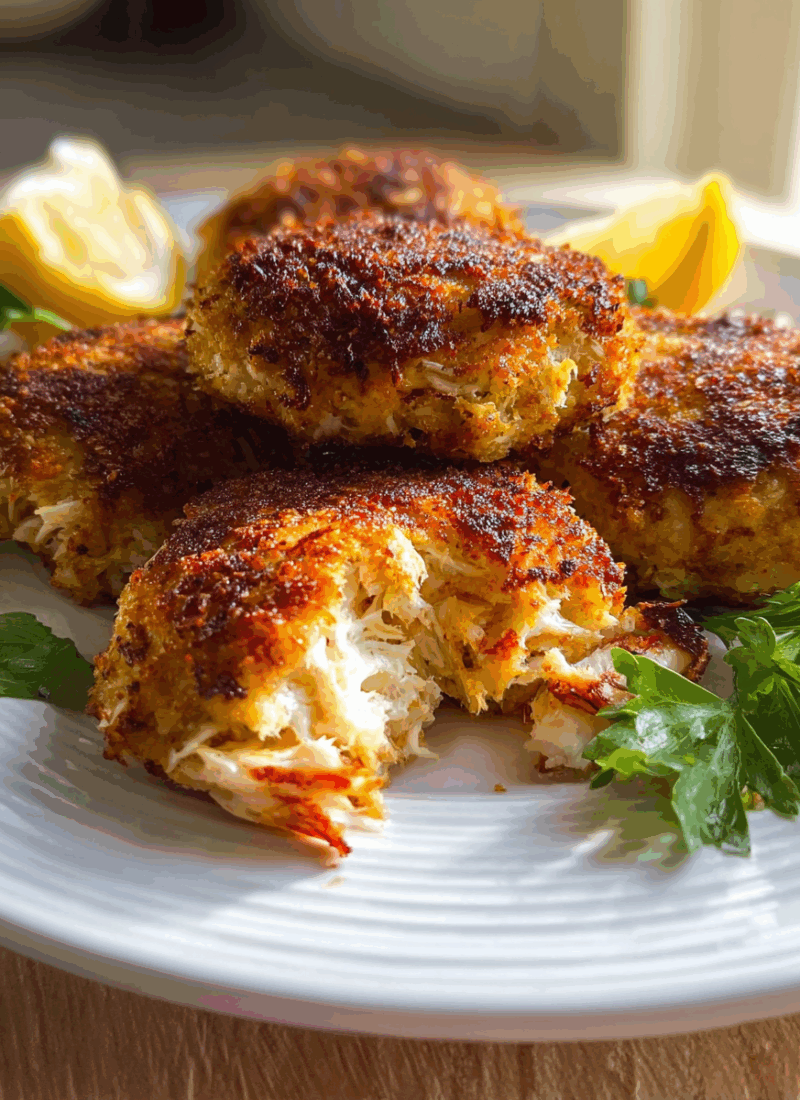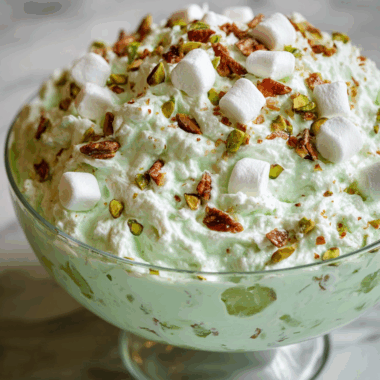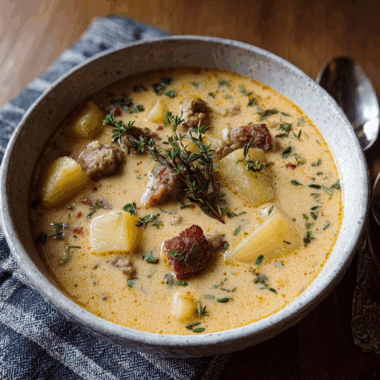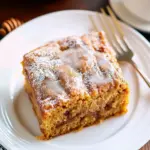These irresistible Baked Crab Cakes are a perfect no-fry option for a light meal or impressive appetizer. With fresh crab meat, simple pantry ingredients, and no messy frying, they deliver crispy golden exteriors and tender, flavorful insides. Ready in under 45 minutes, they’re ideal for a weeknight dinner or a dinner party. Even seafood skeptics love them thanks to their zesty lemon and mild, sweet crab flavor.
Full Recipe:
Ingredients
-
1 lb fresh crab meat (lump or backfin, drained and checked for shells)
-
1/2 cup plain breadcrumbs (or panko for extra crunch)
-
1 large egg (lightly beaten)
-
1/4 cup mayonnaise
-
1 tsp Dijon mustard
-
1 tsp Worcestershire sauce
-
1/2 tsp garlic powder
-
1 tbsp lemon juice
-
1 tbsp chopped parsley (or 1 tsp dried)
-
Salt and pepper to taste
Directions
-
Preheat oven to 375°F (190°C).
-
Mix ingredients: In a large bowl, gently combine the crab meat, breadcrumbs, egg, mayonnaise, mustard, Worcestershire sauce, garlic powder, lemon juice, parsley, salt, and pepper.
-
Chill (optional but helpful): Refrigerate the mixture for 20–30 minutes to make shaping easier.
-
Shape into patties: Scoop about 1/4 cup of the mixture and form into 3/4-inch thick patties.
-
Bake: Place on a parchment-lined baking sheet. Bake for 15 minutes, carefully flip, and bake another 10 minutes until golden brown.
-
Rest & serve: Let them rest for 5 minutes, then serve warm with lemon wedges or your favorite dipping sauce.
Nutrients
(Per 1 crab cake – approximate values)
-
Calories: 120
-
Fat: 5g (1g saturated, 3g unsaturated)
-
Cholesterol: 60mg
-
Sodium: 300mg
-
Carbohydrates: 8g
-
Sugar: 1g
-
Fiber: 1g
-
Protein: 10g
The Beauty of Baking Over Frying
One of the standout advantages of this recipe is the method of baking instead of frying. While traditional crab cakes are often pan-fried in butter or oil, baking offers a lighter and cleaner alternative. It eliminates excess grease, reduces calories, and removes the mess of splattering oil while still achieving a golden, crispy exterior.
Baking also allows for even cooking, ensuring each crab cake is perfectly crisp on the outside while remaining moist and flavorful on the inside. It’s a method that not only simplifies the process but also enhances the overall eating experience.
Why Fresh Crab Meat Matters
The soul of any crab cake is, of course, the crab. Fresh crab meat—particularly lump or backfin—makes a world of difference in both texture and flavor. Lump crab offers large, meaty pieces that provide a luxurious mouthfeel, while backfin blends tender flakes with smaller chunks for a slightly finer consistency.
Using high-quality, fresh crab meat elevates this dish from everyday to exceptional. Unlike imitation crab or overly processed seafood, fresh crab delivers the mild sweetness and natural brininess that make these cakes so irresistible.
Flavorful Simplicity with Pantry Staples
Despite their gourmet presentation, baked crab cakes rely on simple, everyday ingredients to shine. A combination of mayonnaise, Dijon mustard, Worcestershire sauce, garlic powder, lemon juice, and parsley creates a savory, balanced flavor profile. The mustard and Worcestershire bring a subtle tang and umami depth, while lemon juice brightens the entire mixture with citrusy freshness.
Breadcrumbs bind the ingredients together without overwhelming the crab’s delicate texture. Whether you choose plain or panko breadcrumbs, the result is a cake that holds its shape and develops a lovely golden crust when baked.
Versatility for Any Occasion
Another reason crab cakes are so beloved is their versatility. They’re equally at home as an elegant dinner entrée or as finger food for cocktail parties. Served with a fresh green salad, roasted vegetables, or a citrusy aioli, they make a satisfying, restaurant-quality meal.
As an appetizer, they can be formed into smaller portions and paired with dipping sauces like lemon-dill yogurt, spicy remoulade, or garlic aioli. Their rich flavor and attractive appearance make them a hit at celebrations, holiday gatherings, or intimate dinners for two.
Perfect for Weeknights or Entertaining
This recipe’s quick preparation makes it an excellent choice for busy weeknights. From start to finish, you can have dinner on the table in under 45 minutes. The optional chilling step helps the mixture firm up, making shaping easier and yielding perfectly formed patties, but it’s not strictly necessary if time is tight.
For entertaining, the crab cakes can be prepped ahead of time and refrigerated until baking. This allows you to enjoy your guests rather than being stuck in the kitchen during your event. Pop them into the oven just before serving and impress your guests with a warm, golden appetizer that looks—and tastes—like it came from a fine seafood restaurant.
Nutrition with Taste in Mind
These baked crab cakes offer a health-conscious option without sacrificing flavor. Each cake provides a solid dose of protein with moderate fat and minimal carbohydrates. By skipping the frying process, the overall calorie count is kept in check, making this recipe suitable for those watching their fat intake or seeking a lighter alternative to traditional fried seafood.
Using lean, nutrient-rich crab meat also adds omega-3 fatty acids, vitamin B12, and other essential minerals. Combined with fresh herbs and lemon juice, this dish supports both taste and wellness in equal measure.
Serving and Presentation Tips
Presentation plays a big part in the enjoyment of crab cakes. Serving them with a wedge of lemon and a sprig of parsley adds a pop of color and a hint of brightness that complements the rich, savory interior. For added flair, plate them over a bed of arugula or microgreens, or arrange them on a serving platter with ramekins of sauce for dipping.
Pairing suggestions include light white wines such as Sauvignon Blanc or Pinot Grigio, or even a sparkling wine to add a celebratory touch. On the non-alcoholic side, sparkling water with lemon or an herbal iced tea pairs well and keeps the palate refreshed.
Common Mistakes to Avoid
Even simple recipes have their pitfalls. When making crab cakes, overmixing is a common mistake that can lead to a mushy texture. Gentle folding is key to preserving the integrity of the crab meat. Similarly, using too many breadcrumbs can overpower the flavor and dry out the cakes—this recipe strikes a balance that lets the crab shine through while keeping everything cohesive.
Another common issue is overbaking, which can result in dry or rubbery cakes. Keep a close eye during the final minutes in the oven and remove the cakes as soon as they’re golden brown and slightly crisp around the edges.
How to Store and Reheat Leftovers
Baked crab cakes store well in the refrigerator for up to three days when kept in an airtight container. For best results, reheat them in a 350°F oven for about 10 minutes to regain their crisp exterior. Microwaving is not recommended, as it tends to soften the crust and make the texture rubbery.
They can also be frozen for longer storage. To freeze, place uncooked or baked cakes on a baking sheet until solid, then transfer to a freezer-safe bag. Thaw overnight in the fridge before baking or reheating.
Conclusion
Baked crab cakes offer a flavorful, elegant, and healthier twist on a beloved seafood classic. With their crisp edges, moist interiors, and zesty flavor profile, they are an easy yet impressive dish suitable for any occasion—from casual weeknight dinners to upscale gatherings. By focusing on fresh crab meat and a few well-chosen ingredients, this recipe honors tradition while embracing modern preferences for lighter fare.
Whether you’re new to seafood or a lifelong crab cake enthusiast, this baked version promises to become a go-to favorite in your culinary rotation. Simple to prepare, delicious to eat, and endlessly adaptable, baked crab cakes truly prove that you don’t need to fry to achieve perfection.








